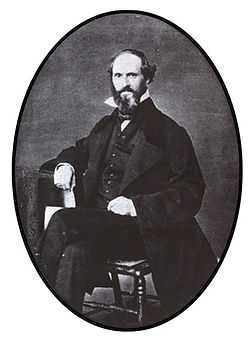Richard Spruce

taken upon his return from Brazil
Richard Spruce (10 September 1817 – 28 December 1893) was an English botanist. One of the great Victorian botanical explorers, Spruce spent 15 years exploring the Amazon from the Andes to its mouth, and was one of the first Europeans to visit many of the places where he collected specimens.[1]
The plants and objects collected by Spruce (mostly in Brazil) from 1849 to 1864 form an important botanical, historical and ethnological resource, and have been indexed at the Royal Botanic Gardens, Kew, London and at Trinity College Dublin.[2]
Spruce cultivated bitter bark quinine, making the drug widely available for the first time. The bark had historically been used by native South Americans as a cure for malaria.[3]
Early life
The son of a schoolmaster, Spruce was born near Ganthorpe, a small village near Castle Howard, in Yorkshire. He lived for some years in Welburn, to the south, before going to South America. After his return, he passed the last 17 years of his life in nearby Coneysthorpe.
As a child, Spruce "showed much aptitude for learning, and at an early age developed a great love of nature. Amongst his favourite amusements was the making of lists of plants, and he had also a great liking for astronomy." In 1834, aged 16, he drew up a neatly written list of all the plants he had found around Ganthorpe. Arranged alphabetically and containing 403 species, the gathering and naming must certainly have occupied some years.
Three years later he had drawn up a "List of the Flora of the Malton District" containing 485 species of flowering plants. Several of Spruce's localities for the rarer plants are given in Henry Baines (botanist)'s Flora of Yorkshire, published in 1840.
Career
This early interest in botany led to his being sent on a collecting trip in the Pyrenees in 1845-6. In 1849 he followed Alfred Russel Wallace and Henry Walter Bates to the Amazon Basin, collecting more than 30,000 plant specimens there and in the Andes during the next 14 years. After returning to England he wrote The Hepaticae of the Amazon and the Andes of Peru and Ecuador.[4]
His paper on the musci and hepaticae of Teesdale, the result of a three-week excursion, showed his skill at locating and identifying rare species. In Baines's Flora of Yorkshire only four mosses were recorded from Teesdale. Spruce increased the record to 167 mosses and 41 hepaticae, of which six mosses and one liverwort were new to Britain.
In April, 1845, he published in the London Journal of Botany descriptions of 23 new British mosses, about half of which he had discovered himself. That year he also published his "List of the Musci and Hepaticae of Yorkshire" in The Phytologist. The list included 48 mosses new to the English flora and 33 new to Yorkshire.
In 1852 he described Banisteriopsis caapi and observed its use among the Tukanoan people of Brazil. The plant is a main ingredient in ayahuasca.
In 1860 Spruce published his twenty-fifth paper, "On the Mountains of Llanganati in the Eastern Cordillera of the Quitonian Andes",[5] which proved to be a valuable resource for explorers of the Ecuadorean Andes. Throughout the twentieth century, countless adventurers and explorers, including Colonel Edwards Cranston Brooks and Commander George Miller Dyott, used Spruce's paper in their quest for the Treasure of the Llanganatis.[5]
In 1864 Spruce was awarded a Ph.D. by the Academiae Germanicae Naturae Curiosum, and in 1866 he was elected a fellow of the Royal Geographical Society.
Quotations
- "...My delicate health and retiring disposition have combined with my love of botanical pursuits to render me fond of solitary study, and I must confess that I feel a sort of shrinking at the idea of engaging in the turmoil of active life..."
References
- ↑ Pearson, M. Richard Spruce: Naturalist and Explorer. Hudson History, Settle, Yorkshire. 2004.
- ↑ Seaward, M. R. D. and S. M. D. Fitzgerald. (eds.) Richard Spruce (1817-1893): Botanist and Explorer. Royal Botanic Gardens, Kew. 1996.
- ↑ Honigsbaum, M. The Fever Trail: In Search of the Cure for Malaria. Farrar, Straus and Giroux, Chicago, Illinois. 2001.
- ↑ Wallace, A. R. (ed) and Spruce, R. Notes of a botanist on the Amazon and the Andes... during the years 1849-1864 by Richard Spruce PhD. 2 vols, cr8vo, Macmillan, London 1908. [the first part of the first volume contains all the text completed by Spruce before his death, and the rest is written by Wallace on the basis of Spruce's notes]
- ↑ 5.0 5.1 Charbonneau, S. J. Lust For Inca Gold: The Llanganati Treasure Story & Maps. CreateSpace Independent Publishing Platform. 2012.
- ↑ "Author Query for 'Spruce'". International Plant Names Index.
External links
 "Spruce, Richard". Dictionary of National Biography. London: Smith, Elder & Co. 1885–1900.
"Spruce, Richard". Dictionary of National Biography. London: Smith, Elder & Co. 1885–1900. - Richard Spruce Collection, Royal Botanic Gardens
Further reading
- Raby, P. Bright Paradise. Chatto & Windus, London. 1996. ISBN 0-7011-4613-3
|